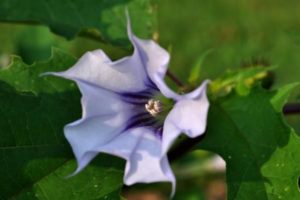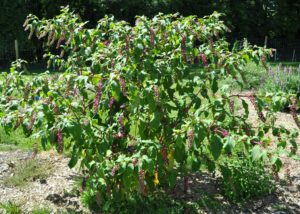Poisonous Weed Precautions and Management
Two problematic weeds in our area are the Jimsonweed and Pokeweed.
We have to pay more attention to weeds. There are very problematic weeds moving into our area (water hemp, palmer amaranth—although I have not yet seen any palmer, and horseweed has been here). Machinery can move weed seed from the Midwest to New York, and from field to field.
Two problematic weeds in our area are the Jimsonweed and Pokeweed—both are poisonous.

Jimsonweed
NYS IPM Program / Flickr Creative Commons
I have had a few questions on Jimsonweed— an annual in the nightshade plant family. It is one of our most
poisonous weeds. One reference noted that a half teaspoon of the seed can be lethal to a human. All parts of the plant are poisonous. It is bitter, so animals may not graze it unless they are hungry. However, a thick patch in a field chopped for silage can be a concern, especially if it has seed. The seeds are the most toxic part. It is a warm season plant, so if it is a problem, it is probably escaping herbicide applications.
Many residual and post emergent herbicides will kill it. To manage it, rotate crops so that it is exposed to herbicides. Mow it (especially along fence lines) often to prevent it from going to seed or getting big. Since it is a big and vigorous plant, control it when it is small. Once it gets several leaves, it will be more difficult to control.
Pokeweed is a perennial and all parts of the plant are poisonous. Gloves should be worn if you are hand pulling many plants. To kill established plants, use a shovel to cut below the crown. Like jimsonweed, many herbicides will kill it and it can be controlled with crop rotation and by managing it while it is young.

Pokeweed.
NYS IPM Program / Flickr Creative Commons
A few questions to ask yourself as you assess your weed situation on-farm include:
- Did you buy any machinery this winter?
- If so, be sure it is thoroughly cleaned, inside and out, of soil and weed seeds, before moving it around at all.
- What weeds did you have last year?
- Think about how machinery will progress from field to field and if you have problematic weeds. Manage the order of field operations, and consider cleaning soil off machinery between fields (especially if it is muddy).
- Did you see some weeds last year that seemed odd?
- One or a few lone weeds can be the start of new problematic weed populations. Get to know your weeds. Do not ignore the lone weed, it may become your nightmare.
Finally, consider using residual herbicides in your weed control program. Some of our weed issues are developing because we are relying on mostly post-emergent herbicides.
This article originally appeared in the Capital Area Ag Report in February 2020, with some minor edits for clarification.

